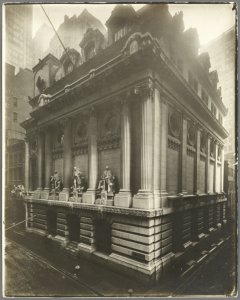Thanks to the copyright laws relating to public domain, it’s fairly easy to find newspaper articles relating to World War I on the internet. While researching the impact of World War I on Greenwich Village, for example, I found many resources in the New York Times digital archive. However, while almost all of the paper’s articles since 1851 are available online, there are very few pictures available to accompany the text. In many cases, older editions of the New York Times didn’t feature many pictures, but in some cases, they were just not included when the article was clipped and scanned. Line after line of printed words does not make for a very exciting digital archive or web exhibit, though, so I set out to find the missing newspaper photographs.
The first resource I’d like to share is one that was recommended by a classmate of mine: the ProQuest Historical Newspapers Database. This database contains scanned copies of 25 newspapers, dating back as far as the 1700s. The New York Times archives from 1851 to 2009 can be found here, just as they can on the New York Times website. Much like the New York Times archive, ProQuest allows you to view whatever pictures were clipped along with the article. However, ProQuest also gives you the option to view the article in “Page View.” This allows you to see the article in context, with all of the articles and pictures that would have surrounded it. In the regular article view there is no way to know whether an article has pictures or not without doing a lot of “guess and check.” Sometimes one article on a topic will have no pictures, while a related article right next to it on the page will have accompanying photographs. Article view, which the New York Times uses exclusively, forces you to look through every article on a given topic to find photographs. ProQuest’s page view, though, allows you to flip through the pages of a newspaper to find related articles and photos you might have missed with a simple keyword search.
There is one major disadvantage to ProQuest Historical Newspapers, though. The database is available by subscription only, which means that grad students like me can enjoy the opportunity to flip through hundreds of years of digitized newspapers, but an independent researcher would have to pay to access this collection. Also, while the pictures are easier to find than they are on the New York Times website, I still felt that there had to be a better way to find good newspaper photographs from the early 1900s.
One of the best resources that I found for these photographs is the newspaper pictorials collection in the Library of Congress’ American Memory Project. American Memory is a digital archive of items from the Library of Congress that aims to document the “nation’s memory.” It includes over 5 million photographs, documents, sound recordings and videos from colonial times through the 20th century. Some of these items are only available online through the Library of Congress and not through their creators.
The American Memory site can be browsed by topic, collection or time period, or by doing a general keyword search. In my case, it was the keyword search that turned up the best results. I searched for “27th Division,” a unit in the US Army in WWI that was welcomed home with a large parade up Fifth Avenue. The results were extensive, and very helpful. Among the long list of articles from the Army’s “Stars and Stripes” newspaper for troops, I found a New York Times result from an entire collection of newspaper pictorials. Feeling intrigued, I clicked the link to the question and a found a wealth of photographic knowledge at my fingertips!

Search results for “27th Division”- Newspaper Pictorials results are fourth, sixth and seventh on the list
Pictorial sections became popular features of American newspapers during WWI. A new process of photoengraving, known as rotogravure, meant that newspapers could produce high quality images on cheap quality paper. With Americans taking part in their first European war, rotogravure pictorials became a useful way to show the American people on the homefront the harsh realities of the war abroad. Each Sunday, the New York Times and the New York Tribune would feature a full section of rotogravure images. The New York Times also published a pictorial section in the middle of the week, and later compiled images from these sections into a book entitled The War of the Nations: Portfolio in Rotogravure Etchings. This volume included images from the mid-week pictorials published from the start of World War One in 1914 until the signing of the armistice in 1919.
The Newspaper Pictorials collection in the American Memory Project includes images from this book, as well as those from the Sunday pictorials in the New York Times and the New York Tribune. The Tribune features a number of hand-drawn images, but the Times has pages of photographs from the war and the homecoming of the troops. While the newspapers themselves are available online or on microfilm, the difficulty of properly scanning the rotogravure sections has made them difficult to obtain until now. Thanks to American Memory, though, the images can be clearly viewed online or downloaded as a PDF. Finally, I had found my missing photographs.







You must be logged in to post a comment.